Standing in front of a tea spread, it’s hard to pick between oolong and green tea. It’s a fun problem many tea fans have! In this guide, we’ll explore the world of oolong vs green tea. We’ll look at their unique traits, tastes, and health perks to guide your choice. 🫖
If you love tea or are just starting, knowing the differences between these teas will make your experience better. It will also deepen your love for this old, soothing tradition. Let’s start this flavorful adventure together!
Key Takeaways
- Discover the unique characteristics of oolong and green tea.
- Learn about the health benefits both teas offer.
- Understand the processing methods that set them apart.
- Compare the flavor profiles to find your perfect brew.
- Get insights on the caffeine content in both teas.
Introduction to Oolong and Green Tea
Let’s start our journey into the world of oolong tea and green tea. These teas share a common root, the Camellia sinensis plant. This plant is rich in history and holds cultural value.
Oolong and green tea are key players in both traditional medicine and modern health. They offer many tea benefits. But, they have different ways of being made, tastes, and health benefits. This makes each tea special in its own way.
Join us as we explore the unique qualities of oolong and green tea. We’ll see how they are different yet connected in the world of tea. Knowing their history and health benefits helps us appreciate them more in our daily lives.
What is Oolong Tea?
Oolong tea is fascinating with its rich history and many flavors. It offers a wide range of tastes and smells. Every sip is a new adventure.
Origins of Oolong Tea
The story of oolong tea starts in China and Taiwan. These places have grown oolong for ages. They use their land to make each tea special.
Tea farmers in ancient China found oolong by accident. They mixed green and black tea to create it. This mix gives oolong its unique taste.
Flavor Profile of Oolong Tea
The flavor of oolong tea is as varied as its origins. It’s like a mix of green and black tea. You might taste peach or roasted nuts.
Oolong tea can be sweet or smoky. It changes every time you drink it. Sometimes it’s floral, other times it’s strong.
Brewing Oolong Tea
Learning to brew oolong tea is key. Use water that’s not too hot. This keeps the leaves from getting damaged.
Try gongfu brewing for a deeper experience. It involves short infusions. Each pour brings out new flavors.
Here’s a simple guide:
| Aspect | Details |
|---|---|
| Origins | China and Taiwan |
| Flavor Profile | Sweet & Fruity to Woody & Thick |
| Brewing Temperature | 185-205°F (85-96°C) |
What is Green Tea?
Green tea is an ancient drink known for its unique qualities. It’s made with simple steps. Each leaf and every sip tells a story.
Origins of Green Tea
Green tea comes from China’s early dynasties. It has a long history in Asia. Farmers use special methods to keep the tea fresh.
These methods include steaming and drying. They come from places like Zhejiang and Shizuoka. These steps help keep the tea’s refreshing taste.
Flavor Profile of Green Tea
Green tea flavors are a journey for your senses. They range from grassy to bittersweet. Matcha is vibrant and umami-rich, while jasmine is floral.
Each flavor tells a story. It’s about the soil and the care it received.
Brewing Green Tea
Want to get the best flavor from green tea? Timing, temperature, and technique matter. Here’s how to brew it right:
- Use water heated to around 160-180°F.
- Steep leaves for about 2-3 minutes to avoid bitterness.
- Select quality tea leaves for the best experience.
Follow these steps to enjoy your green tea. Learn more about brewing at best tea brewing practices.
Oolong vs Green Tea: Processing Differences
Tea processing for oolong and green tea is different. These methods make each tea special. Knowing these differences makes our tea time better.
Oolong Tea Processing
Oolong tea is made by a special process. It’s a mix of green and black tea making. The leaves are dried in the sun and then bruised to start oxidation.
This step is key for oolong’s rich taste. The oxidation level changes the flavor. It can be floral, fruity, or strong. It’s a unique experience in every cup! 🌿

Green Tea Processing
Green tea keeps its fresh taste by quick processing. The leaves are steamed or pan-fried right after picking. This stops oxidation.
This way, the leaves stay green and taste grassy. The tea is light and full of antioxidants. It’s a refreshing drink.
Oolong and green tea show the beauty of tea culture. 🌟 Each method creates a special flavor. It invites us to enjoy every sip.
Health Benefits of Oolong and Green Tea
Tea lovers, rejoice! Exploring the tea health benefits is like embarking on an enlightening journey of discovery. Both oolong and green tea offer unique advantages that contribute significantly to our overall wellness.
Oolong Tea Health Benefits
Oolong tea stands out with its unique blend of antioxidants found in both green and black teas. These antioxidants play a crucial role in safeguarding our cells against damage. One of the most notable oolong health benefits is its impact on metabolism. Studies have shown that oolong tea can increase the number of calories the body burns by up to 3.4%. This can be a game-changer for those on a weight management journey.
Additionally, oolong tea provides multiple health advantages, such as:
- Lowering the risk of diabetes
- Improving heart health
- Providing cognitive support
With its stronger antioxidant and antimutagenic effects, oolong tea is a powerful ally in achieving optimal health and wellness.
Green Tea Health Benefits
Green tea is celebrated for its high levels of catechins, plant-based antioxidants that provide a plethora of green tea health benefits. One of the most renowned benefits of green tea is its ability to foster heart health. By reducing LDL cholesterol levels, green tea contributes to a healthier cardiovascular system.
Green tea is also widely recognized for its potential to boost metabolism and assist in weight loss. Consistent consumption can enhance skin health, offering a natural glow, and providing protection against UV damage.
Whether you choose oolong or green tea, remember that both offer powerful antioxidants and impactful health benefits. Embrace the journey towards a healthier you with every sip!
Taste and Flavor Considerations
Exploring tea is a fun journey through many flavors. Oolong and green teas have different tastes that you might like more. This guide will help you see what makes each special.

Oolong Tea Taste
Oolong tea has a wide range of tastes. You might taste flowers or smoky notes. Each sip is a new adventure for your taste buds.
Whether you like the light, floral tastes or the deep, rich ones, oolong is versatile. Its unique flavors make it stand out.
Green Tea Taste
Green tea, on the other hand, is known for its fresh taste. It’s often described as vegetal. Every cup is a burst of freshness.
If you like a light, consistent taste, green tea is for you. It’s refreshing and has subtle sweet or grassy notes. It’s a treat for your taste buds.
Knowing the differences between oolong and green teas helps you find your favorite. This guide can help you enjoy your tea more. It makes drinking tea a special experience.
Oolong vs Green Tea: Caffeine Content
Ever wondered about the caffeine in tea? You’re in the right spot! Oolong and green tea offer unique experiences. Their caffeine content is a big part of that.
Oolong tea’s caffeine can vary a lot. It depends on the type and how it’s made. Usually, a cup of oolong tea has 37 to 55 milligrams of caffeine. This makes oolong great for morning energy or a gentle afternoon pick-me-up without jitters.
Green tea, on the other hand, has less caffeine. It’s about 20 to 45 milligrams per cup. This is ideal for those who want a light caffeine boost. It helps you stay alert but calm, fitting well into a mindful daily routine.
Here’s a quick look at the caffeine in these teas:
| Type of Tea | Caffeine Content (per cup) |
|---|---|
| Oolong Tea | 37-55 mg |
| Green Tea | 20-45 mg |
Knowing the caffeine content helps you choose wisely. It’s especially useful if you’re sensitive to caffeine or curious about the right tea for you. For more comparisons, check out this comparison of oolong and black tea. It helps you pick the perfect tea for your lifestyle.
Conclusion
Looking back at our journey into oolong and green tea, we see they offer different experiences. Oolong brings complex flavors, while green tea is light and refreshing. Your choice depends on what you like and what you’re looking for.
We talked about their cultural backgrounds, how they’re made, and their tastes. Both teas are good for you, helping with metabolism and focus. Green tea has less caffeine than oolong.
When picking between oolong and green tea, think about what you like, your health goals, and how you react to caffeine. Both teas can lead to a more mindful life. For more on tea’s health benefits, read this article on green tea and honey benefits. Start your tea journey and find the one that fits your lifestyle.


